Matador Network's Blog, page 91
December 4, 2024
The Best Way to See the Monuments in DC? Rent an E-Bike for a Night-Time Solo Tour

The idea to tour the sights of the National Mall in Washington, DC, at night, by e-bike, came from being unable to sleep. Lying awake in my room at The River Inn in the Foggy Bottom neighborhood, I decided to get out and see the city. I was in town for a few days of reporting on environmental lobbying efforts on Capitol Hill, and knew that I wouldn’t have much time for sightseeing. This, my first night in town, was likely the only chance. Walking from the Metro station to the hotel earlier, I’d passed by heaps of e-bikes awaiting their next rider. I am, admittedly, an e-bike evangelist, so I took this late-night opportunity to head out on two (assisted) wheels to see what I could see.
The city is lined with protected bike lanes and paths, including an excellent one along the Potomac River. Once on the National Mall, bike-friendly paths are everywhere, and the perk of doing the tour at night is that there are far fewer people around. Rather than constantly weaving around pedestrians and street vendors, I largely had the paths to myself the entire time. At popular sights like the Lincoln Memorial and the Washington Monument, there were a few people – but I had no issue seeing what I wanted to see up close and then moving on.
How to rent an e-bike in Washington, DC
Photo: John Doe/Shutterstock
Just outside my hotel were multiple bike options to choose from. Lime operates e-bikes rentals throughout the capital, parked randomly throughout town much as the company’s scooters are. There were a few of these within a block of my hotel, and I was delighted to learn I could rent one through my Uber account. Also available throughout town is the Capital Bikeshare, a city-sponsored bikeshare program that stocks e-bikes at designated racks throughout the city center. Though I chose the Lime bike for this excursion, I rented multiple bikes from Capital Bikeshare throughout my time in DC.
It cost $1 to unlock the bike and 15 cents per minute to rent the Lime e-bike. In total, my ride cost $39. This is the same price as Capital Bikeshare, though if you’re a member that price is slightly lower at 10 cents per minute following the $1 fee to unlock.
Routing an e-bike tour of the National Mall
Screenshot from Google Maps by Tim Wenger
Foggy Bottom is northwest of the National Mall. As such, I began my monument tour by pedaling southeast on 26th Street. NW towards Virginia Avenue. I then dipped south onto 23rd Street, past the US Institute of Peace and onto the National Mall. My first stop was the Lincoln Memorial. I pedaled around the back of the memorial and parked my bike on the south side. From there I proceeded on foot up the steps to see the Big Guy himself.
From there I did a full circle around the reflecting pool, of course stopping to remember all the famous movie scenes and iconic news photos that have happened here. I stopped again at the Korean War Veterans Memorial. I then pedaled along the south side of the pool to the World War II Memorial, and onto the Washington Monument. The map embed below is the suggested route by Google Maps, though note that the route I took (pictured in the above screenshot) showcases a bit more of the city.
After seeing these sights, I felt like cruising for a bit. I pedaled through the rest of the National Mall, past the United States Botanic Garden, and took Maryland Avenue over the highway to the Peace Monument. I could see the lights on the Capitol Building this entire stretch of the ride, and though I had that as my unofficial target, I had no idea what to expect at the building itself – obviously, I couldn’t go inside, it was inspiring to ride behind the building past the Garfield Memorial and to the Peace Monument, where I stopped for a few minutes to rest and plan my route back to Foggy Bottom. Much of what I hadn’t seen on the National Mall was in the middle and largely consisted of the Smithsonian Museums, some of which I intended to visit if time allowed throughout my stay, but that wasn’t on the docket for tonight.Instead, I decided to ride past the White House and to McPherson and Farragut Squares en route to The River Inn. This brought me up Pennsylvania Avenue to 15th Street, where I hung a right and rode up to I Street, where I met McPherson Square. I pedaled through Farragut Square and hit the Washington Circle roundabout, then took New Hampshire Avenue back in to the hotel off 25th Street.
How to plan for an e-bike tour of the National Mall
Photo: Maximin Stock /Shutterstock
The entire ride took about 90 minutes, including stopping to check out the sights along the way. With detours not noted on the map, like the jaunt I took down to the Potomac, I ended up cruising about 12 miles, though the route itself is only about seven. It’s largely flat, and because I was on an e-bike the entire time, I didn’t exert a whole lot of effort – though the bike itself was a Level 1 pedal assist, so I did burn a few calories.
If you opt for a bike from Capital Bikeshare, there are racks where you can return or pick up a bike throughout the route, including one near the National Museum of Asian Art and another just south across Independence Avenue. From where I started, the closest was the pickup point at New Hampshire Avenue just south of Washington Circle, a couple blocks from The River Inn.
I visited in September and the weather was nice – it was about 65 degrees during my ride. However, temperatures and conditions can fluctuate, so bring warmer riding clothes in a backpack in case you need to add or remove a layer at any point. 
More People Than Ever Rode Amtrak Trains in 2024

If you’re thinking of taking a train trip soon, you’re probably not the only one. For the past two years, rail travel has been experiencing a significant rise in popularity, filling up trains with travelers all over the world. Earlier this year, Eurail, the biggest name in the world of European train travel, told Matador Network that 2023 was its biggest year on record, with more than 1,237,000 Interrail and Eurail passes sold, a 25 percent growth from 2022. But it’s not just Europe seeing a rail revival. In a December 3 press release, Amtrak reports that 2024 broke ridership records, too.
Amtrak welcomed 32.8 million riders in its trains in 2024, a 15 percent growth from 2023, and the most customers that the National Railroad Passenger Corporation has ever seen in its 53 years in existence.
While we don’t know why more people decided to ride the rails in 2023 and 2024, what we do know is that traveling by train is a greener choice than traveling by plane, with train travel emitting significantly less CO2 per passenger than flying. Something all travelers should keep in mind when planning trips.
That said, it’s undeniable that riding the rail in the US tends to be more time-consuming that flying, especially on long-distance routes, but it’s an exercise in slow travel, and an adventure that many seem to be keen to try, despite the long delays Amtrak is known for.
According to a report by Amtrak, in 2023, all 15 of the railroad company’s long-distance routes, and 15 of the 24 state-supported routes, failed to meet the Federal Railroad Administration’s punctuality standard. Most of the delays, however, can be attributed to freight train interference. In 2023, freight trains caused an incredible 1.5 years of delay to Amtrak trains.
“Breaking our ridership record is just the beginning,” said Amtrak CEO Stephen Gardner. “This record ridership shows that travelers throughout the US want efficient travel options, and we are committed to meeting that demand.”
To satisfy customer demand, this past November, Amtrak launched a new route, The Floridian, bringing a daily and direct train service between Chicago and Miami. And in 2025, also by popular demand, Amtrak will restart the route between New Orleans and Mobile, which was suspended in August 2005 after Hurricane Katrina.
“We are modernizing our network and fleet so we can make every journey with Amtrak world-class,” said Amtrak President Roger Harris. “As we build for the future, our investments in new equipment, expanded service, and critical infrastructure will continue to elevate the experience from coast to coast.”
Amtrak’s rolling stock is in the process of being renewed, with 28 next-generation high-speed trains on order to replace the current Acela fleet, and Amtrak Airo trains, the first one of which will enter passenger service in 2026, to replace the current fleet on 14 long-distance overnight routes.
Amtrak hopes to double its ridership to 66 million customers by 2040. 
Mexico’s New Tax on Cruise Ship Passengers Could Add a Big Cost to Your Next Trip

In a move that’s left the cruise industry reeling, Mexico’s Congress has voted for a new tax of $42 per cruise passenger on a ship docking at a Mexican port. This new levy could take effect as early as next month. And if you’re thinking, “That’s fine, I’ll stay on board,” there will be no avoiding this extra charge. Whether you disembark or not, all passengers will need to pay $42. Previously, cruise passengers were exempt from tourist taxes under the “in-transit” provision of the Non-Migrant Rights policy.
The cruise industry has expressed significant concern over this new tax, fearing it could negatively impact the popularity of Mexican destinations. The Florida-Caribbean Cruise Association (FCCA) has criticized the decision, stating that it will make Mexican ports significantly more expensive than other Caribbean destinations.
Mexico is home to some of the most popular cruise ports in the world. According to the Florida and Caribbean Cruise Association (FCCA), over 10 million passengers visit the country by cruise each year, which means a potential extra $42 million in revenue for the Mexican government.
In a statement, Michele Paige, CEO of the FCCA, expressed surprise at the sudden and unilateral decision to eliminate the in-transit exemption. She highlighted the short notice provided to the industry, which could lead to confusion and inconvenience for travelers, especially those who have already booked their cruises for 2025.
While many popular tourist destinations have implemented fees to address overtourism, the allocation of funds in Mexico’s case raises questions. Two-thirds of the revenue from the new tax will go to fund the Mexican army rather than being used to improve port infrastructure or enhance the visitor experience.
Another concern is that Mexico’s cruise tourism industry significantly contributes to the country’s economy. According to the Mexican Association of Shipping Agents (AMANAC), the cruise industry has created 20,000 jobs in the country. It’s a valid concern that imposing this new tax could deter cruise lines from choosing Mexican ports, leading to a potential decline in visitor numbers and an economic impact.
The $42 per person fee for travelers represents a substantial additional cost, especially for families. If you’re traveling with a family of four, that will cost you an extra $168. Cruise operators will likely collect the new levy.
Industry experts are urging a more collaborative approach between the government, cruise lines, and travel agencies to find sustainable solutions that protect both the environment and the economic interests of the destination.
“I think it’s reasonable for us all — the government, the cruise lines, and travel retailers like myself — to have a discussion of what can we do to protect these beautiful places that we sell,” Ferrara says. “I’m hopeful there will be a better solution.” 
Canada Is Giving Free Flights to the Great White North to “burnt Out Americans”

Americans are known the world over for their dedication to their work. In fact, they are so committed to their jobs and careers that they barely take any time off. According to a 2023 report from the Pew Research Center, 46 percent of US. workers who are entitled to paid time off take less than they are offered. But everyone needs a break from time to time, even the most devoted US worker, and Canada is here to help.
After the frenzy of the presidential election and the stress of Thanksgiving, Destination Canada and flag carrier Air Canada are teaming up to offer free flights to overworked and “burnt out Americans” in dire need of some rest and relaxation away from their compatriots, family members, and colleagues.
All legal residents of the 50 US states and DC who are at least 21 years of age can enter Destination Canada’s SnOOOw Day contest to win two economy round-trip tickets, courtesy of Air Canada. There is a total of 100 round-trip flights to win, one for you and one for the travel companion of your choice.
All you have to do participate is to fill out a form with your basic personal information, and afterwards you can play around with SnOOOw Day’s Out Of Office email generator to mentally prepare yourself to your upcoming, no-work-allowed vacation in Canada.
The Out Of Office email generator will also help you choose the Canadian destination and activities that work best for you, whether that is visiting French-speaking Quebec in winter, partaking in some urban exploring in trendy Vancouver, or learning more about Indigenous traditions on an outdoor trip in Alberta. Canada and its huge variety of landscapes, weather, people, and traditions has something to offer to every type of traveler.
The contest can be entered until December 20, 2024, and the 50 winners will be notified in January 2025. Despite the name of the contest, the lucky Americans who get free flights to Canada won’t have to travel to in the winter, but will be able to pick a date between January 2025 and March 2026 for their jaunt across the 49th Parallel. 
December 3, 2024
Meet the 13 Best Boys and Girls of US Airport Security

If you’ve ever been waiting for your luggage at a US airport and seen a TSA or airport security dog go by, you’ve probably wondered exactly what their jobs are. But you may be surprised to learn just how many different detection, security, and sniffing roles are available to different dogs. For example, Dodo in Portland, OR, sniffs out suspicious materials, while Kipper puts her luscious locks to work in sunny San Diego, CA.
Who are Dodo and Kipper, you ask? They’re two of thirteen of the goodest boys and girls working for the US Transportation Safety Administration (TSA) selected for the 2025 TSA Canine Calendar. And that means these smart pups may have to learn to start signing autographs (paw-tographs?), because each dog has a full-color spread in the calendar. Every month includes not just a glamor shot of each dog, but also additional “photos and fun facts about these canine heroes.” The calendar is available online and is completely free to download. While that’s not as good as getting to pet the dogs in real life, it’s a close second.

Dodo is both a champion sniffer, and champion napper. Photo: TSA Canine Calendar
The TSA employees more than 1,000 working dogs across the country, trained in four different roles: passenger screening canines, explosive detection canines, vapor wake canines, and specialized screening canines, though there are multiple roles within each of those distinctions. Dogs can use their excellent senses of smell to sniff out substances like illegal drugs, explosive materials, or certain remnant gases. Dogs may walk with their handlers around check-in areas at airports, or scan luggage as it comes off conveyer belts in the arrival section. Dogs can also be used behind the scenes to detect suspicious luggage and cargo, or may even be used to check individuals as they enter the country or move through security checks.

If you don’t use the calendar for date keeping, you can use it for hair inspiration. Photo: TSA Canine Calendar
The majority of TSA’s dogs (and all the dogs in the TSA canine calendar) are large breeds like German shepherds, labradors, and pointers, many of whom can be adopted by the public after they retire. Other agencies tend to use smaller dogs known for their excellent noses, including the US Department of Agriculture, which uses primarily beagles and beagle mixes to detect contraband agricultural items. But regardless of what agency the dogs are working for, the most successful four-legged officers are those with a high combination of intelligence, temperament, and ease of training (and a strong sense of smell, of course). Most dogs are there to keep airports safe from explosives and other security threats, not to bust travelers who may have had a little marijuana in their bag at some point.

Bruno loves both sniffing out danger, and playing with his squeaky Kong Wubba toy. Photo: TSA Canine Calendar
The 2025 TSA canine calendar is full of fun facts like these, as well as information about the history of the canine program and some useful packing and traveling tips. But the best facts are those about the dogs themselves — did you know Barni of California’s San Francisco International Airport also won 2024’s TSA “Cutest Canine” contest? If you’re wondering how they decide which dogs made the cut, you may be happy to know nearly all the nominees are included toward the end in a round-up of TSA’s fluffiest officers. 
You Can Spend Months at Sea With Virgin Voyages’ New All-You-Can-Cruise Annual Pass

After the success of Virgin Voyages’ Summer Season Pass which, when it first launched in 2024, sold out in just two days, the cruise line is introducing its Annual Pass.
Virgin Voyages’ Annual Pass grants holders unlimited cruising for 365 days on any of the cruise line’s four ships (including the Brilliant Lady debuting in September 2025), and on any of their itineraries, whether that be sailings in the Mediterranean, the Caribbean, North America, Alaska, Europe, and even transatlantic crossings.
Virgin Voyages Annual Pass is the first of its kind in the cruising industry.
The pass is available for purchase now and until March 31, 2025. Pass holders can choose between four starting dates for their Annual Pass: January 1, February 1, March 1, or April 1, 2025.
While the cruise line’s website states that “there are a limited number of Annual Passes”, in an email conversation, a spokesperson for Virgin Voyages explains “we’re currently not capping how many passes we’re offering.”
The Annual Pass, which includes complimentary laundry, premium WiFi, a $100 bar tab for each itinerary, and two specialty coffees per day, is meant to appeal to those who can work remotely and ditch their rentals to spend one year at sea. Note that shore excursions are not included in the pass but that pass holders get priority access to select Shore Things.
Needless to say that in purchasing this pass, travelers aren’t signing up for a dreary inside cabin. Pass holders get a Sea Terrace cabin with a square footage ranging from 185 to 225 square feet, and a balcony from where pas can take in the sea views.
The best part of the pass, however, is likely the fact that its price of $120,000 (plus taxes) includes a plus-one, whom you can change as many times as you want throughout the year.
While $60,000 per year per person remains a hefty price, when you include all the perks, it’s much lower than other long-term cruises, including Royal Caribbean’s famous Ultimate World Cruise, which cost between $54,000 and $117,000 per person for a nine-month period, and most much shorter world cruises.
If you can’t swing such a big sum, you can opt for the cruise line’s Summer Season Pass, which is back for 2025. The Summer Season Pass offers the same benefits as the Annual Pass but for a much shorter period: from 24 to 40 nights, starting at $14,999. 
This Adults-Only Hotel Encapsulates The Best of Spain’s Costa Brava

Since hearing about the “Wild Coast” of Spain, I felt drawn to the northeastern corner of Catalonia. The Costa Brava is a 140-mile clutch of rocky swimming coves backed by stone pine and fig trees misting over the remnants of medieval watchtowers. Camí de Ronda walking trails skirt the craggy cliffs and crumbling tunnels once patrolled by frontier guards as they rounded up smugglers.
Cala del Pi Beach Resort, an adults-only Sallés Hotel, sits on a bluff at the northern end of Platja d’Aro and is named for the itty-bitty cove below the overhang. The hotel is set back enough from town to guarantee peace and quiet during high season, but not so far back as to feel disconnected. As part of the Empordà region, this five-star seaside hotel is a base for wine tourism as well as hiking, cycling, and sailing.
We hope you love Cala del Pi Beach Resort! Just so you know, Matador may collect a small commission from the links on this page if you decide to book a stay. Listed prices are accurate as of the time of publication.
Modern Mediterranean rooms with a view
Photo courtesy Casa del Pi
When in the Med, never say “no” to a sea view. I was left speechless watching the sun rise and set from the balcony of my Deluxe Sea View Room. At night, I left the balcony doors open to benefit from a soothing breeze and soundtrack of waves. Although rooms have blackout blinds, I left these open to enjoy dawn wake-up calls.
The decor had a nautical touch with a sand and pebble gray palette; hardwood flooring and corrugated wood panels added warmth and texture. The rest of the hotel carries a subtle marine theme through carvings of sea creatures and glass chandeliers that made me think of shoals. Some areas sported countryside artifacts, harking back to the building’s original purpose as a masia, or traditional farmhouse.
All 49 rooms come with a terrace and most have a sea view but there are a few exceptions. Waking up to a sea view was a highlight of my stay, followed swiftly by a nightly spa circuit.
Rest, relaxation, and wildness at Cala del Pi Beach Resort
Photo courtesy Casa del Pi
Cala del Pi Beach Resort pulled out all the stops with its spa: 600 square meters (6,458 square feet) of twinkling aquamarine mosaics, handsome terracotta columns, and jetted gizmos. Hotel guests have two hours of complimentary use each day whereas non-residents can enter for a fee of €40 (about $42). The suite features a large pool with hydrotherapy beds, cannons, and massaging waterfalls.
There’s also a hot tub (almost made redundant by the pool), foot spa, dry sauna, steam room, and a trio of therapeutic showers. Guests can flit between the facilities or follow the suggested spa circuit. I visited the spa each evening and rated the nighttime ambiance; daytime visitors will appreciate the sunlight trickling in through the glass roof.
The hotel has three tiered outdoor pools surrounded by Mediterranean foliage. The largest – and deepest – almost creates the illusion of an infinity pool. The hotel’s “Yoguilates” and “Aquayoga” classes are free for guests. There are three weekly classes in summer and one per week in winter.
Cala del Pi is one of the prettiest Costa Brava beaches in Platja d’Aro. This cove has a mix of sand and fine pebbles plus natural diving boards popular with local daredevils in summer. Even during fall, I could splash around without catching a chill.
This public beach is shared by hotel guests and the Platja d’Aro community who turn up on evenings to kick a ball around. As the Camí de Ronda crosses through the beach, there is a steady flow of long-distance and day hikers passing by. After countless jaunts down to the beach, I can confirm the hotel’s private passage has fewer steps than the public path.
Mediterranean dining à deux
Photo: Hannah D. Cooper
The adults-only Restaurante Aurum serves Catalan cuisine to a Costa Brava seascape. There’s a well-rounded selection of shellfish and many fish dishes are infused with Iberian cuts. Around a third of the dishes are designed to share between two – after all, this is a hotel for romancing.
After a day spent vaulting over boulders and grazing on bocadillos, all I wanted to do was conk out on my balcony and catch the last hour of daylight. Room service, it was. The truffle risotto was thick with Iberian pork and nutty porcini. On the side, I pecked at tomato-rubbed bread and was glad I left room for a lip-smacking Manchego cheesecake.
The air had an autumnal nip to it during my November stay but I was perfectly content to sit outside on the terrace for breakfast each morning and imagine what a sweet spot this must be in summer. The buffet spread was Mediterranean through and through: I piled my plate with grilled asparagus and bell peppers, drizzled olive oil over crusty bread, and nibbled on cold cuts and pastries. Besides a selection of zumo de naranja, there were bottles of cava and light white wines from the Empordà hills.
The bars and restaurants of Platja d’Aro are within tottering distance of Cala del Pi Beach Resort. A taxi takes just five minutes.
Getting around the Costa Brava
Photo: kavalenkava /Shutterstock
Just south of the midway point between Portbou and Blanes, the hotel’s location in the heart of the Costa Brava can’t be beat. It’s helpful but not essential to have a car in Empordà – it streamlines getting around the inland villages and seaside towns. As the Costa Brava and Girona Pyrenees are a major cycling destination in Spain, the region has great infrastructure for road and mountain bikes. Cala del Pi Beach Resort has ample parking and bike storage.
Regional buses are operated by Moventis and tend to be at least an hour apart; seasonal schedules are displayed at bus stops and posted online. It’s wise to pre-book tickets during summer but otherwise, they can be purchased at bus stations and onboard. The fastest buses to Platja d’Aro from Girona take around an hour and Girona-Costa Brava Airport is 30 minutes away.
Cala del Pi Beach Resort can assist with curating Empordà wine tours and private sailing excursions. The Wild Coast is by far the most adventurous of the Spanish costas, and while it would be tempting to hole up for a week of sunning and spa-ing, it would do the region a disservice. 
These Cruise Lines Are the Only Ones to Let You Snorkel and Dive in Antarctica

While Antarctica is remote, it’s hardly inaccessible any longer, even for tourists. Well over 15 cruise lines travel to the seventh continent during the Antarctic summer, and while restrictions apply, many of them even land on Antarctica. The cruise lines that are allowed to organize landing activities go all out in what they offer their passengers: polar plunges in the icy waters of the Southern Ocean, kayaking and SUPing sessions around icebergs, camping on the ice, penguin-viewing hikes, and Zodiac rides in search of wildlife. While both Scenic Cruises and Seabourn offer submarine excursions during their sailings to the seventh continent, only two operators give their passengers the chance to have the ultimate adventure: snorkel and dive in Antarctica.
Oceanwide Expeditions
Photo: Oceanwide Expeditions / Andrew Peacock
Oceanwide Expeditions is a Dutch, adventure-focused operator that sails in several locations in both the Arctic and the Antarctic. During its voyages to Antarctica, Oceanwide Expeditions offers polar diving excursions from three of its ships: the M/V Hondius, the M/V Ortelius, and the M/V Plancius. Oceanwide Expeditions is working on adding snorkeling to their Antarctica sailings, but this activity is not currently available.
Who can dive in Antarctica with Oceanwide Expeditions?Polar diving in Antarctica is only available to travelers with at least 30 dry-suit dives under their belts. To prove their experience, the divers are required to show and provide copies of an internationally accepted diving certificate and their logbook. The first dive of each trip is a test that allows the dive leader to gauge the level of experience of each guest, and travelers to test out their equipment and get used to the temperature of the water. Guests who do not meet the necessary requirements during the test dive will not be allowed to dive again.
What it’s like to dive in Antartica with Oceanwide Expeditions?Guests dive from Zodiac at safe locations twice per day if the weather and sea conditions allow. All the diving expeditions are led in English by certified and experienced instructors, including one dive leader and one or two guides. Oceanwide Expeditions has a dive guide-to-diver ratio of one to six.
Travelers can expect to dive at a maximum depth of 65 feet and explore shipwrecks and ice walls, and observe marine creatures, including penguins, several species of starfish, sea butterflies, fur seals, soft corals, and many more — possibly even leopard seals.
While Oceanwide Expeditions provides tanks and weights, divers need to bring their own equipment, including dry suit, face mask, and all other accessories.
How much does it cost to dive in Antartica with Oceanwide Expeditions?Ocean Expeditions’ 10-day Antarctica — Whale Watching Discovery and Learning Voyage, scheduled to take place between March 10 and March 20, 2026, starts at $7102 for a berth in a four-person cabin. Other more costly options are available for booking in both 2025 and 2026.
Aurora Expeditions
Photo: Scott Portelli / Aurora Expeditions
Aurora Expeditions, is an Australian, B Corp-certified expedition cruise line that has been operating for over 30 years. In fact, Aurora Expeditions was the first expedition cruise operator in the world to offer polar diving, and has been offering polar snorkeling since 2014. While Aurora Expeditions’ focus is small-ship voyages in the Arctic and the Antarctic, the cruise line also sails in Asia, Oceania, Latin America, and around Europe. Two of Aurora Expeditions’ ships, the Greg Mortimer and the Sylvia Earle, both of which have a maximum capacity of 130 passengers, sail to Antarctica every year.
Aurora Expeditions’ voyages to Antarctica are meant for the adventurous travelers as the operator offers a multitude of outdoors activities, including skiing, sea kayaking, alpine trekking and climbing, and scuba diving and snorkeling in water as cold as 30˚F.
Who can dive in Antarctica with Aurora Expeditions?Only Advanced Open Water divers and Drysuit Specialty certified divers are allowed to scuba dive in Antarctica with Aurora Expeditions. Not only that but they need to have logged at least 30 dry-suit dives, with a minimum of 10 dives in the 12 months before the trip, five of which must be in a dry suit. All travelers planning to scuba dive during their trip need to present an internationally accepted diving certificate, logbook, and recent diving medical so they can be approved prior to departure.
What it’s like to dive in Antartica with Aurora Expeditions?The first dive of the trip will be a test for all the divers to check and adjust their equipment, and for the dive master to evaluate everyone’s competence. Anyone not meeting the needed requirements will be excluded from this activity. After the test dive, travelers can expect to dive twice per day, but this activity is dependent on weather and sea conditions.
All the dives organized during Antarctica sailings with Aurora Expeditions are led by highly experienced guides and are done in groups of six divers maximum.
Divers can expect to dive at a maximum depth of 65 feet and encounter marine life such as giant isopods, spider crabs, jellyfish, penguins, whales, seals, and many more.
How much does it cost to dive in Antartica with Aurora Expeditions?The scuba diving activity is available for a fee of $940 on top of the price of the voyage.
Travelers can participate in scuba diving on the following Aurora Expeditions voyages:
Wild Antarctica featuring the Weddell SeaSpirit of AntarcticaAntarctic ExplorerSpirit of Antarctica featuring the Chilean FjordsAntarctic Explorer featuring the Chilean FjordsWho can snorkel in Antarctica with Aurora Expeditions?Unlike scuba diving, snorkeling in Antarctica does not require any previous experience. All necessary training will be provided on board.
What it’s like to dive in Antartica with Aurora Expeditions?Expect to snorkel at least once per day, depending on the conditions, and see icebergs below the water, penguins, crustaceans, nudibranchs, and more.
All the snorkeling is led by expert guides with many years of experience, and is done in safe locations, including sheltered bays, off-shore islands, and secluded shipwrecks.
Unlike with diving, all the equipment for snorkeling is provided on board the ship for those who wish to partake, including specially designed Waterproof Snorkel-Drysuits, gloves, hood, fins, mask, and snorkel.
How much does it cost to snorkel in Antartica with Aurora Expeditions?Snorkeling is available for an additional fee of $835.
Note that at least six guests must sign up for the snorkeling activity to proceed.
Travelers can snorkel on the following Aurora Expeditions voyages:
Wild Antarctica featuring the Weddell SeaSpirit of AntarcticaSouth Georgia, Falklands, and Antarctic OdysseyAcross the Antarctic CircleAntarctica CompleteFalklands, South Georgia, and Antarctic Peninsula More like thisTravelYou Can Sail to Antarctica on This Tall Ship - but It's Nothing Like a Cruise
More like thisTravelYou Can Sail to Antarctica on This Tall Ship - but It's Nothing Like a Cruise
Vietnam’s New 957-Mile, High-Speed Train Will Make Travel so Much Easier
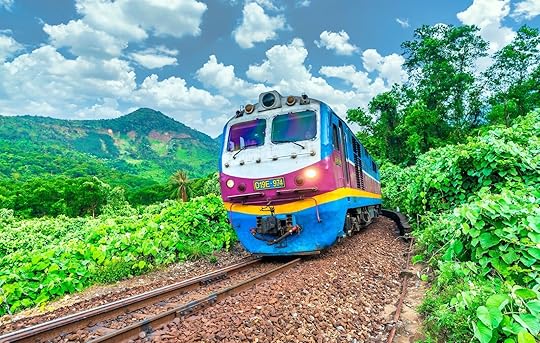
Vietnam is possibly one of the best countries in the world for slow travel, with streets best discovered on foot and lots of charming cafes and coffee shops where relaxing over an affordable, fresh meal is one of the best ways to spend an evening.
But slow travel isn’t really possible for travelers with only two weeks (or less) of vacation time. Fortunately, Vietnam can still be on your travel radar if you only have a week to see the country, as the government just formally approved a brand-new high-speed train to connect the major cities of Hanoi and Ho Chi Minh City. But you’ll have to wait a few years to plan that trip, as construction isn’t planned to start in 2027, and is estimated to take at least seven years to complete.
Currently, it takes about 35 hours by standard rail to travel from Hanoi, in the northern part of the country, to Ho Chi Minh, in the south. And that time increases for anyone hoping to make stops in some of the country’s other popular tourist destinations, like Hue, Da Nang, and Hôi An. The new rail project will shorten that trip down to just five hours, with 23 stops in cities and medium-sized towns.
The new high-speed rail will cover 957 miles (1,541 kilometers) and is expected to cost roughly $67 billion. That money is expected to come primarily from the Vietnamese government, though it said it would consider Chinese investments, given its proximity to the country. That cost is driving most of the opposition to the project, as the county’s gross domestic product (GDP) in 2023 was $429 billion — meaning that a spend of $67 billion is an enormously large figure.
When the idea for the high-speed rail was proposed a few years ago, some Vietnamese legislators expressed opposition to the project, stating that the fares would likely be too expensive for the average citizen, and that the route would do little to improve transportation options for people living in small and more remote towns. As with other projects like the Tren Maya through Mexico’s Yucatan Peninsula, opened in late 2023, some have also raised concerns about whether route planners will do their due diligence in ensuring construction doesn’t cause any negative environmental or cultural impacts.
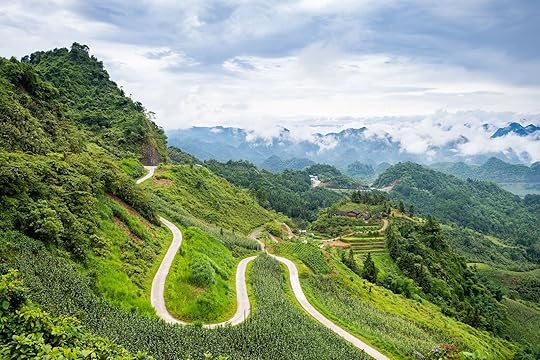
Travel by road is the primary means for getting around most of the country. Photo: Jon Chica/Shutterstock
Currently, Vietnam’s infrastructure is rated fairly low for road safety, ranking below countries like Kazakhstan, Bosnia, Sierra Leone, and nearly 70 others. Vehicle accidents are low (and motorbikes are more common than cars), but there are many small, not-well-maintained roads through the countryside mountainous and hilly terrain, especially in the northern part of the country around Sapa. Supporters say the train will also help the country get to its ambitious goal of being zero net emissions by 2050.
Vietnam would not be the first country in the region to introduce a pricey high-speed rail project. Indonesia inaugurated Southeast Asia’s first high-speed railway, the Jakarta-Bandung High-Speed Rail, in 2023. The 88-mile rail line connects the capital city of Jakarta with the town of Bandung, reducing travel time from just over three hours to approximately 40 minutes. In 2021, Vietnam’s neighbor Laos opened a 257-mile line between Vientiane and Bowen, making it easier to travel throughout Laos. And China is continuing to expand its high-speed railway, which currently totals more than 25,500 miles — representing 66 percent of all high-speed rail Lins in the world. 
[readlink readtext=”More like this:” title=”How to Get the New 90-Day Vietnam Tourist Visa” url=”https://matadornetwork.com/read/how-t...” logo=”true”
This Hotel Is Perfect for Seeing Tokyo by Train (Especially If You’re Solo)
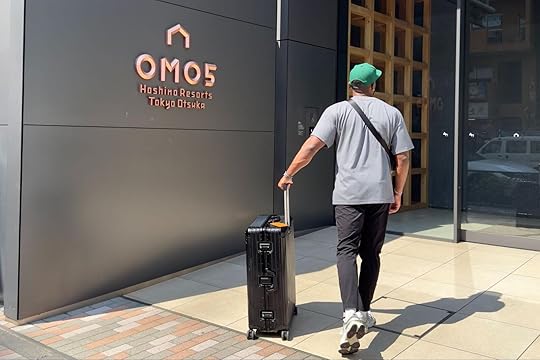
Traveling around Japan by rail requires you to be strategic about the hotels. The right hotels need to be close to the areas you want to visit — and, crucially, even closer to the nearest train station.
On a recent trip to Japan to photograph Mount Fuji, among other rail-based adventures, I found that OMO5 Tokyo Otsuka fit the bill in more ways than one — it’s located just two minutes from Otsuka Station, which runs through many of Tokyo’s most popular areas; it has traditional-style rooms with modern touches; and it’s filled with amenities that make settling into both the hotel and the neighborhood a breeze.
The vibe at OMO5 Tokyo Otsuka: A hotel that draws you in and helps you get out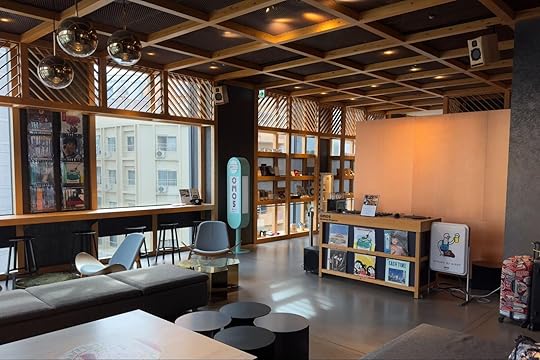
Photo: Rick Southers
Your first hint that OMO5 curates a mini world unto itself amid Tokyo’s sprawl is the elevator that takes you up to the main lobby from the street once you enter the building. When you exit the elevator, you’ve arrived at OMO Base, the aptly named common area where you can work or socialize, grab a snack, and plan your daily travels.
The lobby lounge was designed to resemble a train car since train travel is such an integral part of exploring Tokyo. Benches and handrails along the windows add to the theme that this is a place that’s meant to connect you with the rest of the city. There’s a large map of the surrounding neighborhood on the wall, packed with local restaurants, shops, cafes, bakeries, breweries, and other attractions. There are also maps available to lead you on your adventures.
Further into the lobby, you’ll find local goods, snacks, and drinks for sale. The whole lobby was designed to be a social gathering space, complete with a permanent DJ booth setup where the hotel hosts nightly parties. The music was a great mix of pop, hip hop, and even some 1990s RnB. The nighttime events were the perfect activity to connect with other travelers and exchange favorite spots around the city before heading out to go bar-hopping or to a late dinner.
The rooms at OMO5 Tokyo Otsuka: Loft-style lodging means extra comfort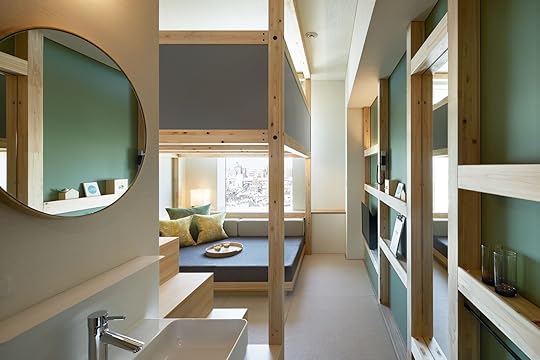
Photo: OMO5 Tokyo Otsuka by Hoshino Resorts
OMO5 feels intimate like a boutique hotel, but it has 125 guest rooms. I stayed in a Yagura Room, the standard offering. (Yagura translates to “tower” and refers to a customary style of wooden structure in Japan.) The first thing I noticed upon entering my room was the half-bath located behind a door on the right and the separate room housing the combo bathtub and shower next to it. Then I saw the sink and mirror located in the common area just before reaching the stairs that lead up to the sleeping area.
I was pleasantly surprised by how spacious my room was because of the elevated loft-style bed. The living area underneath was lined with tatami mats, making for a cozy space to kick off your shoes, watch TV, and relax on the wide day bed. Local sumo matches were my entertainment of choice during my stay. Beneath the stairs, I found plenty of storage for clothes and luggage. There was also a coffee maker and a safe to store valuables.
Efficient design was a theme throughout the room. Another example of thoughtful, space-saving touches was the built-in shelving and hooks on the walls to hang things like clothes or towels. This was the perfect spot to hang my camera. My room was on one of the higher floors and provided a great view of the neighborhood — another reason to keep my camera nearby.
Yagura Rooms have an average nightly price of $117 with breakfast included.
The food at OMO5 Tokyo Otsuka: From hangover breakfasts to late-night bites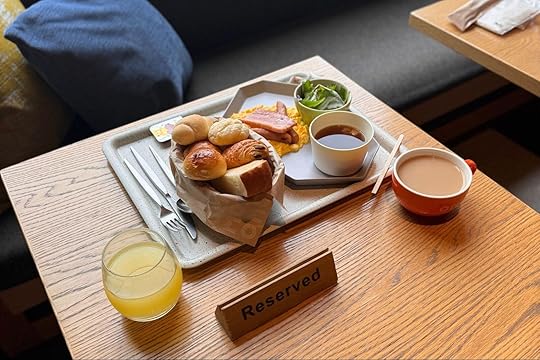
Photo: Rick Southers
Adjacent to the main lobby, you’ll find the casual OMO Cafe & Bar. The cafe features a walk-up counter where you can select pastries and beverages throughout the day. The counter is located across from a seating area that has about a dozen tables and booths. OMO Cafe & Bar also serves coffee, snacks, beer, and other spirits until 11 PM.
The hotel breakfast is available every morning until 10:30 AM. You can choose between the fukagawa-meshi (a specialty Japanese rice dish similar to seafood risotto that the hotel has branded as “OMOrning Risotto”) or an American-style breakfast that comes with eggs, bacon, and a variety of breads. Opt for the fukagawa-meshi if you’ve had a late night — it’s affectionately known to locals as a hangover cure.
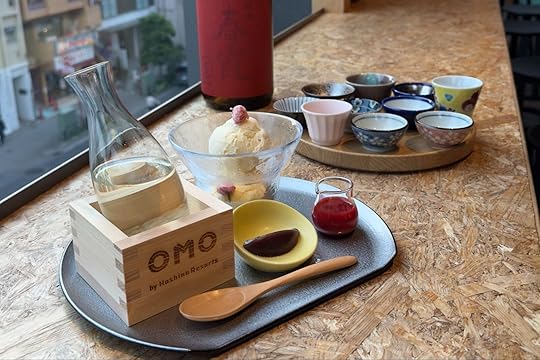
Photo: Rick Southers
After a short tour of the property, I was invited to join a fun culinary experience at the hotel: a sake and ice cream tasting. I wasn’t sure what to expect from the combination, but the floral sake was a perfect compliment to the sweet ice cream and strawberry syrup. This was a seasonal treat offered to all guests and promoted on colorful posters throughout the hotel.
In the neighborhood: Guided tours and sightseeing from OMO5 Tokyo Otsuka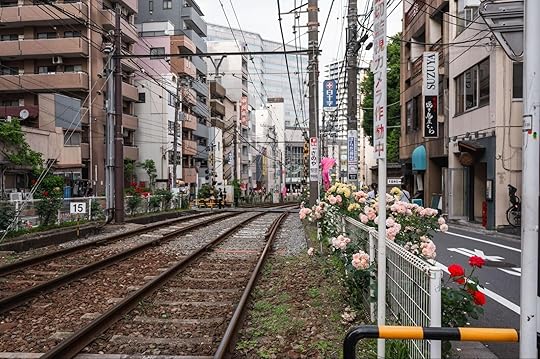
Photo: Rick Southers
Once I arrived in Otsuka, I was met with colorful roses lining the Sakura railway and friendly neighborhood restaurants and shops all around. OMO5 was an approximately two-minute walk from the station. During my short walk I was offered tea, invited into an izakaya (a type of Japanese bar that serves food) spot that smelled heavenly, and passed a conveniently located 7-Eleven where I stopped for snacks and drinks.
Once I was settled in at the hotel, I took advantage of the neighborhood tour, a staple activity at the property. The tour is free of charge for hotel guests and departs every morning at 11 AM. You’ll need to make a reservation in advance and then meet in the lobby for departure.
Walking around Otsuka with the hotel guide felt more like being invited into the home of a good friend. We were offered tea and pastries at various shops, and we received friendly waves everywhere we went. There was a very popular ramen restaurant located next to the hotel that had a line meandering down the street farther than I could see. I took note of that and a few other places to visit over the coming days. My first stop of the night would be for izakaya at Otsuka Torichu, a local dive that was highly recommended by my tour guide.
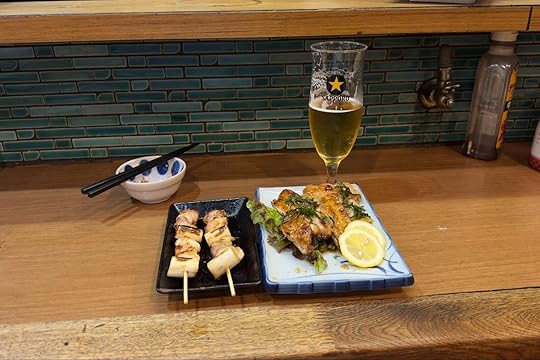
Photo: Rick Southers
Venturing out into Tokyo was as simple as crossing the street and entering the train station. I could see the trains coming and going from my room, so a five- to 10-minute head start was more than enough time. I frequented Yoyogi Park for coffee in the mornings, Ginza for shopping, and Shibuya to check out speakeasies and photograph the busy intersections at night.
Ginza is a high-end fashion district where I checked out some watch boutiques like Swatch and Omega. I also got to explore the Uniqlo flagship store, which has a restaurant on the top floor. Shibuya is the most lively neighborhood at all times of the night and the place where I spent many late nights. My favorite speakeasy was Music Bar Cave, a dimly lit basement restaurant that plays vintage vinyl tracks and serves high-end cocktails.
When it was time to venture further out to Kyoto and Mount Fuji, it was convenient to only have to haul my luggage a few minutes to the station. I could get to Tokyo station in less than 30 minutes to connect to the Shinkansen train and travel out into the countryside.
Getting to OMO5 Tokyo Otsuka and getting around Tokyo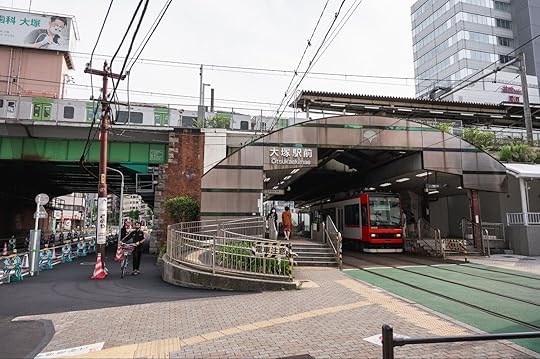
Photo: Rick Southers
From Tokyo’s Haneda Airport (HND), it was easy to navigate to the hotel by train. First, I traveled to Tokyo Station and then transferred lines to reach Otsuka Station after some stops. OMO5 was just two minutes on foot from the station. Rail is also a great way to get around Tokyo and Japan at large. While rideshare services like Uber are available in Tokyo, rideshares are a less time- and cost-efficient way to navigate the city. 
Matador Network's Blog
- Matador Network's profile
- 6 followers



